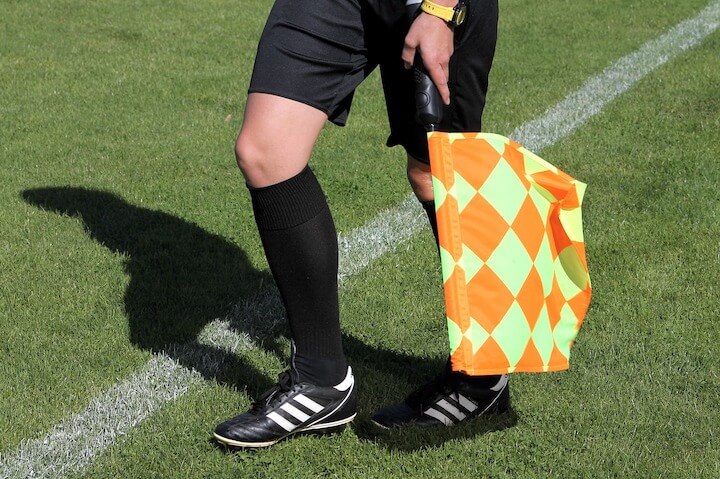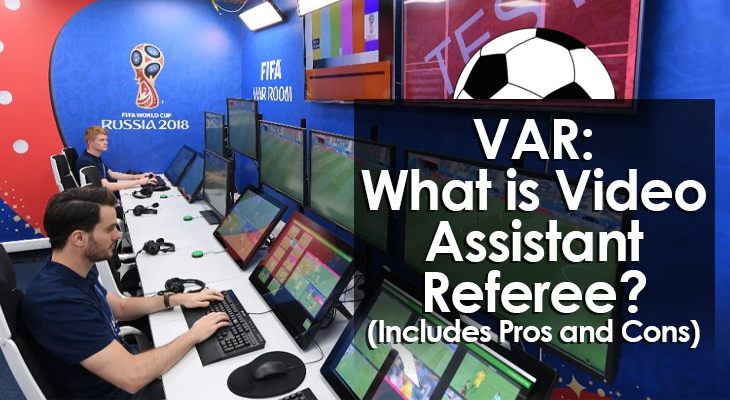What is Video Assistant Referee? (VAR Pros and Cons)
VAR (Video Assistant Referee) is one of the more recent additions to the rules of soccer.
This allows a second review by the referees for important moments in a soccer game with the aim of reducing instances of errors in judgment.
In this text, we take a look at the background of the technology, the way it functions, and the pros and cons of its implementation.
A Brief History of VAR
The idea behind VAR stems as far back as 2010 but it did not make it to the major soccer leagues until six years later.
In 2016, the International Football Association Board (IFAB) as overseers of the Laws of the Game, approved trials for video referees or "live experiments with video assistance for clear errors in match-changing situations".
The first instance of these trials in the major leagues was in the MLS (Major League Soccer) in 2016. The trials ran a few times before the league fully started to implement it in games.
Full implementation began in the MLS and the Australian A-League in 2017, followed by the major European leagues such as the German Bundesliga and the Italian Serie A.
The English Premier League, however, was a bit late to the party.
They officially started using VAR in the league for the first time in the 2019/20 season, following the success of extensive testing in the previous season.
What are the Basics of VAR?
A key difference between the standard referring process and VAR-supported is that there are more people involved in the decision-making process.
Instead of a single referee making the decisions, there is a team of three referees that work together to review the decision or play call.
There's still just one main referee that goes onto the pitch, but these 3 other referees work behind the scenes -- reviewing video footage of relevant moments to help the main referee make a decision.
This takes place in a video operation room somewhere in the stadium.
The room typically contains multiple monitors that display various camera angles of the pitch.
These angles are critical as the main referee cannot see all these angles with the naked eye.
The team working together usually include:
- The main video assistant referee
- The referee’s assistant
- A replay operator
The Principles Of VAR
The following principles apply in every game with a VAR protocol, in accordance with the laws of the game:
- Officials may only use VAR for clear and obvious errors (categories discussed above).
- The main referee always has the final say.
- VAR are match officials and treated as such.
- The referee cannot delegate the final decision-making to the VAR.
- The main referee cannot change the original decision or call unless the video review shows that the error is “clear and obvious”.
- There is no time limit for the review process once it begins.
- The players and team officials must not try to interfere in any way while the referee tries to review and make a decision.
- Players and coaches have no need to request a review as the VAR will automatically do so if needed.
- The referee is the only one allowed in the RRA (Referee Review Area), cautioning any player or team official that enters.
- The referee must be visible during the review process for full transparency.
What is the Process for Requesting VAR?
The process works in two ways:
(1) The VAR team may recommend a review through the communication lines to the referee after a decision or call, or (2) the referee can request a review to be sure that they made the right call.
It is the duty of the VAR to always notify the referee when they judge that a decision made was incorrect.
The referee can then decide if the call is in need of a review or not.
In every VAR review situation, the referee has three options:
- Follow the recommendation of the VAR,
- Stick with the initial decision, or
- Review the incident on the monitor placed by the side of the pitch before making a decision.

When is VAR Used In Real-Time?
Referees typically have to make hundreds of decisions throughout a match.
Therefore, it would be extremely ineffective to use VAR in all situations due to the amount of time that will it will take.
On that note, there is a select category of decisions that officials use VAR for.
Four potentially match-changing situations.
1. Goal / No Goal
Referees may use VAR to help determine if a goal should stand in the following situations:
- If the attacking team commits an offense in the build-up to their goal such as a foul, handball, or offside.
- If the ball is adjudged to have gone out of play in the build-up to the goal
- If during a penalty kick, the goalkeeper/penalty taker commits an offense, or there is encroachment for a defender/attacker who becomes involved in play if the penalty rebounds off the post, crossbar, or the goalkeeper.
2. Penalty / No Penalty
Penalty decisions are often game-changing, making VAR confirmation necessary under the following circumstances:
- If the attacking team commits an offense in the build-up to the penalty incident, such as a foul, handball, or offside.
- If the ball is adjudged to have gone out of play in the build-up to the goal
- If there is a case that the offense was actually committed outside the box
- If there is a case that the penalty was incorrectly awarded
- If there is a case for a penalty offense that was not seen or awarded by the main referee
3. Direct Red Cards
The use of VAR is necessary in direct red card situations where:
- Based on the position of the players, a defender denies an obvious goal-scoring opportunity with a foul
- There is a serious foul play from a reckless challenge
- A player is adjudged to have conducted themself violently (e.g biting or spitting at an opponent)
- A player uses offensive/insulting gestures or language
4. Mistaken Identity
Believe it or not, there have been cases of mistaken identity at the highest levels of soccer, where a player is incorrectly penalized by the referee for another player’s offense.
Example below.
Officials make use of VAR in these situations too. However, unless the offense involved leads directly to a goal, penalty, or red card, the offense itself is not reviewed.
The identity of the offender will be under review, adjusting the decision if necessary.
The Pros and Cons of VAR
The introduction of VAR has been one of the most controversial changes made to the game in modern soccer history.
To this day, the decision remains a controversial one, and there is a lot of split opinion on the matter.
There are benefits to the use of the technology, but there are also drawbacks that the game could definitely do without.
But, do the pros outweigh the cons?
We’ll let you decide!
Pros of VAR Technology
- Referees make mistakes -- the ability to make an informed decision with a video review leads to better overall decision-making.
- Soccer thrives on excitement and drama -- the use of VAR intensifies that with the tension and uncertainty in the air when a video review is being made.
- Players are more disciplined, knowing it is more difficult to get away with infringements with all the angles VAR provides.
- Controversial calls are less frequent since VAR reduces the
- Reduced instances of incorrect match-changing decisions, making controversial calls are less frequent.
Cons of VAR Technology
- Waiting for a VAR decision takes time; the tension can be good, but sometimes the delay also becomes too much.
- The lack of access to the communication process between the main referee and the VAR team leaves some doubt in the minds of the fans, players, and team officials.
- Incorrect decisions are still made with VAR, as human error is not completely removed.
- Depending too much on VAR can have a negative impact on the referees’ confidence in their ability to make the right decisions on their own.
Conclusion
As things stand, the addition of VAR to soccer will remain a controversial topic in soccer for years to come.
However, it seems very unlikely that leagues will change the system anytime soon, so fans will just have to make do.
Perhaps as time passes and more tweaks will occur to perfect the system, there will be less controversy around its use.
What are your thoughts?
Should VAR stay, or is it time to scrap the idea?

